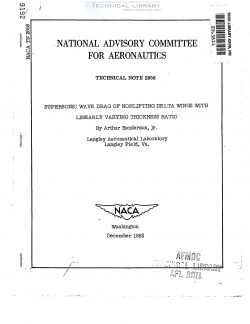naca-tn-2858
- Version
- 140 Downloads
- 1.15 MB File Size
- 1 File Count
- January 17, 2017 Create Date
- January 17, 2017 Last Updated
National Advisory Committee for Aeronautics, Technical Notes - Supersonic Wave Drag of Nonlifting Delta Wings with Linearly Varying Thickness Ratio

The supersonic wave drag of-a nonlifting, symmetrical, double?
wedge-profile, delta wing the thickness ratio of which varies linearly
in the spanwise direction is calculated by means of linear theory.
In general it is found that a delta wing with linearly varying
thickness ratio can have less wave drag than a constant—thickness-ratio
delta wing of the same plan form when both wings have either the same
projected frontal area or the same internal volume. The thickness
distributions for minimum drag and the corresponding values of the ratio
of the drag of a linearly varying thickness—ratio wing to a constant-
thickness-ratio wing are found.
In reference 1, Puckett has found the supersonic wave drag of a
nonlifting, symmetrical, double—wedge-profile, delta wing with constant
thickness ratio. It is shown that the drag coefficient for the delta
wing may be reduced below the two-dimensional value only for the case
in which both the leading edge and the ridge line are subsonic, the
maximum reduction for a given Mach number and semiapex angle being a
function of the position_of the ridge line. ’
In the present paper the additional effect on the drag of varying
the thickness ratio in the spanwise direction is determined with the
assumption that the thickness ratio varies linearly in the spanwise
direction, which means that, when the wing is viewed from behind, the
line of maximum thickness has a parabolic shape., The source—distribution
method develOped in reference 1 is used to represent the variable—
thickness-ratio wings.
It is shown that the deviation of the maximum—thickness line from
a straight line can be represented by a nondimensional parameter. Charts
are presented from which, if this parameter is known, the drag of a
variable-thickness-ratio delta wing can be found. Also shown is the fact
that a delta wing with a linearly varying thickness ratio can give less
wave drag than a constant-thickness-ratio delta wing when both wings have
the same projected frontal area or when both have the same internal
volume. The value of the nondimensional maximum-thickness—distribution
parameter, for which the ratio of the drag of the variable-thickness-
ratio wing to the drag of the constant-thickness-ratio wing is a minimum,
is calculated for both criteria.
| File | Action |
|---|---|
| naca-tn-2858 Supersonic Wave Drag of Nonlifting Delta Wings with Linearly Varying Thickness Ratio.pdf | Download |

Comment On This Post